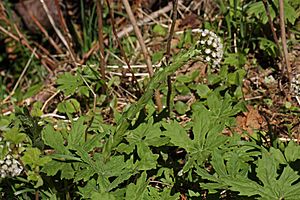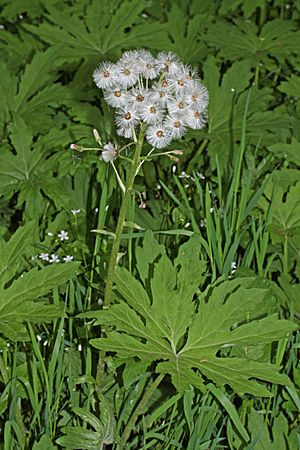Arctic sweet coltsfoot facts for kids
Quick facts for kids Arctic sweet coltsfoot |
|
|---|---|
 |
|
| Arctic sweet coltsfoot | |
| Scientific classification | |
| Genus: |
Petasites
|
| Species: |
frigidus
|
| Synonyms | |
|
|
Petasites frigidus, also known as the Arctic sweet coltsfoot or Arctic butterbur, is a cool plant from the daisy family called Asteraceae. It grows in cold places around the world. You can find it in the northern parts of Europe, Asia, and North America.
Contents
What Does Arctic Sweet Coltsfoot Look Like?
This plant is a herbaceous perennial. This means it has soft stems, not woody ones like a tree. It also lives for more than two years, coming back each spring.
In early spring, it grows flowering stems that are about 10 to 20 centimeters (4-8 inches) tall. These stems have a few yellowish-white or pink flowers. Later in the summer, large, rounded leaves grow directly from its underground roots.
The leaves are quite big, about 15 to 20 centimeters (6-8 inches) wide. They have a deep cut at their base and slightly wavy edges. The underside of the leaves feels soft and fuzzy, like wool. This plant likes to grow in damp, shady spots, often near stream banks.
Different Kinds of Arctic Sweet Coltsfoot
Scientists sometimes disagree on how many types of Petasites frigidus there are. But many agree on five main varieties. A variety is like a subgroup within a species, with slight differences.
- Petasites frigidus var. frigidus
- Petasites frigidus var. nivalis: This type is often found high up in mountains, in subalpine and alpine areas.
- Petasites frigidus var. palmatus: This one is also called palmate coltsfoot. Some Native American groups, like the Konkow, have names for it, such as mâl-ē-mē’ or tä-tä-tē’. The root is called pē’-wē.
- Petasites frigidus var. sagittatus: This variety is known as arrowleaf sweet coltsfoot.
- Petasites frigidus var. vitifolius
How People Use Arctic Sweet Coltsfoot
Some parts of the Arctic sweet coltsfoot can be eaten. The leaf stalks and the flower stems (with their flowers) can be cooked and eaten like a vegetable.
People have also made a salt substitute from the leaves. They dry the leaves and then burn them to create a black, powdery substance. This powder can add a salty taste to food.
However, it's important to be careful. This plant can contain natural chemicals that might not be good for you if you eat too much. So, if you ever try it, only eat a very small amount.
See also
 In Spanish: Petasites frigidus para niños
In Spanish: Petasites frigidus para niños


